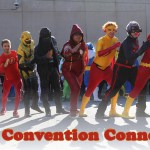Reading Time: 8 minutes
Space has always been something that’s fascinated me. Being a child of the Shuttle era, I’m not old enough to remember the Apollo moon landings; however, that did not stop the landings and space exploration from having a huge impact on my life. One of my earliest memories is of the Challenger accident. It was a month before my fourth birthday, and in its way it set me on the path of my life. I grew up marching my space LEGO across a large paper moon map out of a book that my dad owned. I read any book I could get my hands on about space, fiction or non-fiction. I built and flew model rockets. During high school I was considering majoring in art for college. After a few lukewarm portfolio reviews, I came to realize that most of what I drew were dragons, castles, airplanes, and all things space. An engineering summer camp my junior year confirmed that perhaps I was more interested in designing, analyzing, and building airplanes and spacecraft than just drawing them.
While in undergrad I got to visit Kennedy Space Center for the first time on a swim team trip, worked on cleaning up a V-2 engine that the school owned (the V-2 engine is, in many respects, the predecessor of most modern liquid fueled rocket engine designs), communicated with the Canadian Arrow X-Prize team whose design was based heavily on the V-2 (they used the school’s engine to get measurements), took orbital mechanics and astrodynamics classes, got books signed by Gene Kranz (Failure Is Not an Option) and Eugene Cernan (The Last Man on the Moon), and mourned as tragedy struck a second time. Columbia crashed in February of my junior year.

After graduation and a few years at a job that was not great, I got a job at Kennedy Space Center! For nearly 3 years I got to work at one of the HIGH ALTARS OF GEEKDOM! I was part of the team that prepared the components of the International Space Station for launch. My primary assignments were leading and supporting crane lifts and other component moves. I had hoped to see one shuttle launch in person in my life time; I got to see 11 (STS-116 – STS-127) plus a smattering of Delta II, Delta IV, and Atlas V launches.

Shuttle launch preparations for ISS modules fit the following rough frame work. The module would arrive at KSC/Cape Canaveral Air Force Station (CCAFS) / Port Canaveral via a large aircraft (such as a C-5 or An-124 / -225), cargo ship or even truck for smaller components. Often several years before launch. The modules would be mostly assembled. When they arrived at the Space Station Processing Facility (SSPF) https://science.ksc.nasa.gov/facilities/sspf.html. The processing teams would then work on any final installations, of fluids and electrical equipment, including experimental hardware, astronaut quarters, etc. Numerous fit checks, electrical checks, fluid checks, and a battery of other test. A few weeks before launch the hatches are closed, the module is weighed, and loaded in to the Canister. The Can, was a 65 foot long, 107,000 pound (20 meters / 48,500 kilograms) boiler plate replica of the Shuttle’s payload bay. The canister provided a sealed clean environment for the module to travel in. The module / Can was then taken to the CRF (Canister Rotation Facility). Here the combined Can and payload (often weighing 140,000 pounds / 63,500 kilograms or more) would be rotated to vertical for delivery to LC-39. After the approximately 10 mile (16 kilometer) journey from the south end of KSC to the launch pad the Can/payload would be hoisted to the Payload Change-out Room (PCR) in the Rotating Service Structure (RSS). This would happen before the Space Shuttle arrived at the pad. The RSS protected the Orbiter while pad operations were ongoing, and was retracted before launch. Once the Canister was attached to PCR the payload would be removed using a sidewise crane called the Payload Ground Handling Mechanism (PGHM, pronounced Pig’em). The Canister would be removed and the Shuttle stack would arrive on the crawler. After rotating the RSS over the Shuttle the Payload would be transferred into the Orbiter, and final preparations for launch would be made.

Now Launch Complex 39A/B, or the Shuttle Launch Pads are/were interesting places (they have change greatly since I left). Starting at ground level (which is 6 feet off of sea level) is the flame trench, a massive 490 feet long, 58 feet wide and 42 feet deep (149 x 17.7 x 14.6 meter) structure that directs the fiery exhaust and steam of a launch away from the Shuttle, and before it the Saturn V, currently the Falcon, and someday the SLS. At 95 feet off of sea level is the top of the Mobile Launch Platform when it was at the pad (this is what the Saturn V’s and Shuttles would sit atop of before launch). With the exception of the mobile launch platform and the PCR and White Room clean areas the “floor” of all levels of the launch tower are open grating, so at the PCR you have a 124 foot (37.89 meter) view all the way to the bottom of the flame trench, with some railings to the side. Being right on the ocean it can be pretty windy. I was once at the PCR with Michel of the Canadian Space Agency prepping for STS-123. Michel’s hobbies included being a SCUBA instructor, sky diving and hang gliding. The combination of the wind, open grating and the low light (I don’t recall if this was pre-dawn or dusk) was enough to weird him out. The astronauts enter the shuttle at the 195 foot level, and the pad structure extended well above that.
I worked mostly with the team from the Japanese Space Agency (JAXA) in preparing their modules for launch. These are what are often referred to as Kibo, but I will always know them by their earlier designation: JEM-PM (Japanese Experiment Module – Pressurized Module), ELM-PS (Experiment Logistics Module – Pressurized Section), JEM – EF (Exposed Facility, often called “the back porch”) and the ELM – ES (Experiment Logistics Module – Exposed Section). Working on the JEM – PM gave me what will be my Jeopardy story if I ever get on the show. What follows is the long version.

Astronauts Mike Fossum and Ron Garan, crew members of STS-124 that would deliver the PM to the ISS, were having difficulty in the Neutral Buoyance Lab (NBL, the massive pool at Johnson Space Center in Houston where astronauts practice Extravehicular Activities (EVA’s (Spacewalks)). Releasing the robotic arm on the JEM – PM from the launch restraints was very difficult in the NBL. The question was: Is the mock up in the pool wrong or is this a problem we will have in space? To find out the answer Fossum made plans to travel to KSC to inspect the flight hardware. To make things more interesting the launch restraint in question was located at the top of the module. The module had also been recently moved out of its rotating work stand to a static work stand. We had a solution to getting the astronauts on top of the module: the Removable Overhead Access Platform (ROAP pronounced rope). (Yes, NASA has an acronym for everything, even nested ones at times. One of the pieces of advice I was fond of giving new hires was just accept the acronyms the ones you need to know what they stand for you’ll figure out). Now the ROAP was a great piece of hardware in theory. It consisted of an inverted U shaped structure with train wheels so it could slide along the tracks built into the work stands and 4 platforms that could move vertically and extend allowing for access anywhere in the middle of the U. This is where the theory ends and the execution gets messy. Extendable platforms mean reconfigurable railings, which means having to wear a climbing harness over your clean room bunny suit, and being attached to a fall-arresting inertia reel (they work on the same principle as seat belts, they mechanically sense acceleration and bring you to a rapid stop, should you fall). The gear ratios chosen in the mechanisms made moving or extending the platforms very slow. Finally the ROAP had a reputation for being temperamental.

All this leads to me starting a day with the NASA Program Manager ending the daily meeting with the phrase “Michael, don’t drop an astronaut today!” (I’d like to say that I had some great witty reply, or even something more than a “Yes, sir” or “That’s the plan”, but I don’t remember.) Later that day I met with Astronaut Mike Fossum, and the team of technicians that would be assisting. We got the ROAP positioned, Fossum got access to the launch restraint, and wearing EVA gloves he tested the release mechanism several times, and decided that it would not be an issue on the EVA and the problem was in the NBL in Houston. While I’ve heard there is a theory that astronauts bounce quite high when you drop them, I did not test it that day.

While supporting the JAXA missions was a large part of my duties, I also worked the missions that delivered Node 2, Node 3, several of the solar arrays, the Cupola, several ISS resupply flights, and the final servicing flight to the Hubble Space Telescope. STS-125 (Atlantis) was a neat mission, it had several last in the shuttle program. Because the Shuttle had limited ability to change its orbit (to change a spacecraft’s orbital angle in relation to the equator, or inclination, takes a very large amount of energy) a rescue shuttle had to be staged. The Hubble Space Telescope has an orbital inclination of 28.5o the same as the latitude of KSC, (without extra fuel expenditure once in orbit getting to an inclination angle lower than the latitude of the launch site is not possible). The International Space Station has an Inclination of 51.6 o so that the Russian partners can reach the ISS from Baikonur Cosmodrome in Kazakhstan. Thus the ISS could not be reached if something went wrong. STS-400 (Endeavour) was the one Shuttle Mission no one wanted to see launched. The need for a rescue mission is what caused two Shuttles to be at the Launch Complexes 39A and 39B for the last time. While having a shuttle at both pads was uncommon, it happened 19 times in 30 years (mostly in the early 1990’s). It was also the last time a Shuttle was at Launch Complex 39B. Fortunately it was not the last Shuttle launch from LC39B that is STS-116 in December of 2006 (my first launch). At the time all of our work instructions were printed and kept in binders. Paper clips, staples and pencils were not allowed in clean rooms for Foreign Object control. Imagine how much it would suck to get a staple, that popped out of someone’s papers, float into your eye in orbit! HST took things further due to the extreme sensitivity of the optics. All work instructions had to be printed on yellow lint free paper. The yellow would stand out from the standard white and pink that was used for work instructions. The paper had a woven cloth like feel to it. I worked mostly the download for this mission. The components that the astronauts replaced on the HST were had to be removed from Atlantis payload bay. The flown Hubble hardware was then turned over to the Smithsonian. COSTAR (Corrective Optics Space Telescope Axial Replacement) which I helped download is currently on display at the National Air and Space Museum in Washington D.C.

Other memories include walking through the doors that the astronauts come out of to ride to the launch pad often (except before a mission they are just regular doors, still it’s pretty cool),

Crew of STS-126 exiting the Operations and Checkout building. Picture by Michael J.
working on Launch Complex 39A both with and without the Shuttle there, Space Launch Complexes 17 (Delta II), and 41 (Atlas V), seeing several of the Apollo Astronauts speak at the 40th anniversary of the Apollo 11 moon landing,

and one of my favorite things, giving new hires the tour of all the historic pads and sites.


I met a few astronauts in my time there (in addition to Fossum) and all were incredibly grateful to those of us in the ground crew, taking the mindset of Newton “If I have seen further it is by standing on the shoulders of Giants.”
Although I had to move on in my career, (because of the retirement of the Space Shuttle.) I know what work I have done has helped laid the ground work for many scientific advances, and future exploration of the Moon, Mars, and beyond. I do miss working in the space program, but now I spread the wonder of space travel with my children, coworkers, scouts, you our readers, and whoever else will listen to me.
Click through to read all of “Apollo 50th: Living the Dream: My Time Working on the ISS” at GeekDad.If you value content from GeekDad, please support us via Patreon or use this link to shop at Amazon. Thanks!




